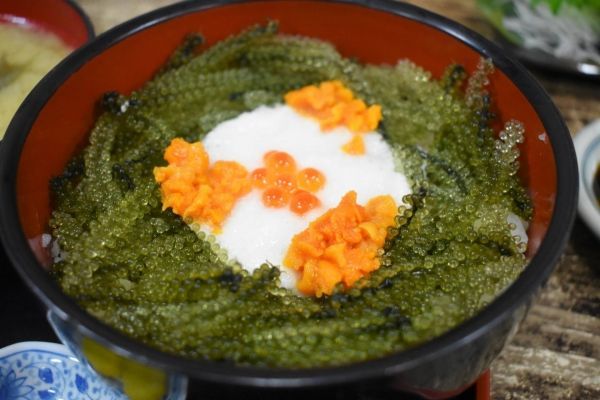If you’ve ever dined on the tropical island of Okinawa, Japan, your plate may have been graced by a remarkable pile of seaweed, each strand adorned with tiny green bubbles. Known as umi-budo or sea grapes, the salty snack pairs well with rice, sashimi and a tall glass of beer. But umi-budo is more than an iconic side dish; it’s a staple crop for Okinawan farmers. Researchers at the Okinawa Institute of Science and Technology Graduate University (OIST) recently decoded the sea grape genome to learn about the plant’s unique morphology and assist farmers in proper cultivation of the succulent seaweed.
“Many farmers face problems with sea grapes growing poorly. Today, they don’t know why such problems occur,” said Dr. Asuka Arimoto, first author of the study and a postdoctoral scholar in the OIST Marine Genomics Unit, led by Prof. Noriyuki Satoh. “Our genomic data can show them which genes are causing such trouble.” With a catalog of all the genes controlling sea grape growth, said Arimoto, the researchers may be able to help farmers diagnose deficient plants when they crop up. The research could also help curb the spread of closely-related green seaweeds, which harm the environment by pushing out local plant varieties in the Mediterranean Sea and Pan-Pacific.
The study, published February 28, 2019 in DNA Research, utilized sample sea grapes from the Onna Village Fishery Cooperative, whose greenhouses are located just around the corner from OIST campus. The scientists deciphered the full sea grape genome and compared it to 15 published plant genomes, collected from unicellular algae, a type of moss, rice and thale cress. The research revealed key genes that allow sea grapes, a unicellular organism, to don its complex shape, and demonstrated the utility of using the algae to explore evolutionary processes in green plants.
Read more at Okinawa Institute of Science and Technology Graduate University (OIST)
Image: Umi-budo don is a traditional Okinawan dish prepared with the umi-budo seaweed. The seaweed is served over rice with sea urchin, salmon roe and sanbaisu sauce, made from equal parts soy sauce, vinegar, and mirin. (Credit: OIST)


